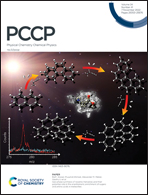A molecular dynamics study of the nonlinear spectra and structure of charged (101) quartz/water interfaces†
Abstract
The relationship between the nonlinear spectra and the structure of charged (101) α-quartz/water interfaces was investigated by classical molecular dynamics simulations. The results of the simulations show that the layered organization of interfacial water is only slightly perturbed by the surface charge and the ionic strength of the aqueous phase. Molecules next to the surface, in a bonded interfacial layer (BIL), tend to direct one of their OH bonds towards the surface, while the water orientation further from the surface, in a diffuse layer (DL), is essentially isotropic. A Stern layer of solvated cations is built up already on a neutral surface and the deprotonation of silanols leads to the formation of an inner Helmholtz plane of cations directly interacting with the SiO− surface sites. A flip of the molecular orientation in the DL could be inferred from the analysis of the structural characteristics of concentrated NaCl solution in contact with a highly charged surface. The computed spectra of χ(2) susceptibility show a double band structure typical of the spectra of silica/water interfaces and the calculations reproduce the experimentally observed variation of the spectral intensity with the pH of the liquid phase. The analysis of results suggests that the behaviour stems from the interplay between the orientational and induced components of the χ(2) susceptibility of the BIL and DL. The dependence of the Im[χ(2)] spectra of the BIL on the surface charge yields the spectrum of H2O molecules directly interacting with SiO− sites. The spectrum is in excellent agreement with the experimental spectrum of the topmost water of a silica/water interface [Urashima et al., J. Phys. Chem. Lett., 2018, 9, 4109].

- This article is part of the themed collection: 2022 PCCP HOT Articles


 Please wait while we load your content...
Please wait while we load your content...